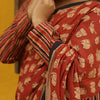Guide to the Cultural Significance of Saree Colors
- by Divyesh Patel
Dive into the rich tapestry of saree colors, where each hue holds profound cultural meanings. From red symbolizing passion and fertility to blue embodying wisdom and spirituality, explore a world of symbolism. Green signifies growth and harmony, yellow exudes happiness and energy, and white epitomizes purity and peace. Each color tells a story, linking heritage with emotions and traditions. Discover the intricate web of cultural significance woven into the threads of every saree color, reflecting deep-rooted values and beliefs.
Red: Symbol of Passion and Fertility
The color red in sarees holds deep cultural significance as it symbolizes passion and fertility in various traditional contexts. Red, a vibrant and bold hue, is often associated with fire, energy, and life force. In Indian culture, red sarees are commonly worn by brides as it represents the intensity of love, desire, and marital bliss. This cultural symbolism of red extends beyond weddings, with red sarees also being donned during festivals and celebrations to evoke a sense of joy and vitality.

Moreover, red is believed to signify fertility and prosperity in many traditional settings. Women often choose red sarees when attending religious ceremonies or auspicious events to invoke blessings of abundance and growth. The rich red tones in sarees are a visual representation of power, strength, and determination, making them a popular choice for women who want to exude confidence and charisma. Embracing the traditional significance of the color red in sarees allows individuals to connect with their roots and showcase a bold expression of passion and vitality.
Blue: Essence of Wisdom and Spirituality
Symbolizing wisdom and spirituality, blue sarees hold a profound cultural significance in various traditional contexts. The color blue, often associated with the vastness of the sky and the depth of the ocean, represents tranquility, introspection, and a connection to the divine. When draped in a blue saree, one emanates a sense of calmness and inner peace, reflecting a deep-rooted understanding of oneself and the world.
Blue saree symbolism goes beyond aesthetics; it delves into the essence of wisdom, encouraging individuals to seek knowledge, truth, and understanding. In many spiritual practices, wearing blue attire is believed to enhance one’s spiritual connection and promote a harmonious balance between the mind, body, and soul.
Embracing a blue saree not only showcases a refined sense of style but also signifies a profound respect for the virtues of wisdom and spirituality. Whether donned for a special occasion or daily wear, the blue saree serves as a reminder to nurture one’s inner growth and embrace the path of enlightenment.
Green: Representation of Growth and Harmony
In the cultural realm, green sarees symbolize growth and harmony, embodying a profound connection to nature and renewal. The color green, often associated with lush forests and vibrant meadows, evokes a sense of natural beauty and tranquility. When draped in a green saree, one not only adorns themselves in a garment of elegance but also carries forward a symbol of environmental awareness.

The verdant hue of green sarees represents the cyclical nature of life, mirroring the regenerative properties found in the natural world. Just as leaves sprout from branches and flowers bloom in spring, wearing a green saree signifies a celebration of growth and rejuvenation.
Yellow: Significance of Happiness and Energy
Yellow sarees exude a vibrant aura, symbolizing an infusion of happiness and energy into one’s attire. The color yellow is often chosen for sarees worn during festive celebrations and joyful occasions due to its association with vibrant energy and a sunny disposition. When draped in a yellow saree, one radiates a sense of positivity and enthusiasm, spreading joy wherever they go.
In cultural contexts, yellow sarees are not only a fashion choice but also a reflection of the wearer’s inner happiness and zest for life. The color yellow has the power to uplift spirits and bring a sense of warmth to any gathering. It is a hue that signifies optimism and a bright outlook on life, making it a popular choice for those who want to express their joyful nature.

Whether attending a wedding, a religious ceremony, or a cultural festival, opting for a yellow saree can instantly elevate your mood and create a celebratory atmosphere around you. Embrace the vibrant energy that yellow exudes and bask in the radiance of this joyful color as you celebrate life’s special moments.
White: Purity and Peace in Tradition
Yellow sarees radiate joy and energy, and similarly, white sarees hold a deep cultural significance representing purity and peace in tradition. White sarees symbolize various aspects that transcend time and space, embodying meanings that have evolved over generations. Here is a closer look at the symbolism and evolution of white saree traditions:
- Symbolism of White Sarees:
- White sarees are often worn during religious ceremonies and rituals, symbolizing purity, spirituality, and a connection to the divine.
- Modern Interpretations:
- In modern times, white sarees have found a place beyond traditional contexts, symbolizing elegance, simplicity, and sophistication.
- Cultural Evolution:
- The significance of white sarees has evolved with changing societal norms, reflecting shifting perceptions of purity, femininity, and grace.
- Timeless Elegance:
- Despite cultural shifts, the timeless elegance of white sarees continues to captivate hearts, making them a symbol of serenity and tranquility in a fast-paced world.
Frequently Asked Questions
What Is the Historical Origin of Saree Colors?
Explore the rich history of saree colors, tracing their origin back to ancient civilizations. Witness the evolution of hues through time, reflecting cultural shifts and traditions. Unravel the intricate tapestry of colors that adorn sarees.
Are There Regional Variations in Color Symbolism?
In the realm of saree colors, regional differences play a crucial role in color symbolism. Cultural variations shape the significance attached to specific hues, reflecting diverse traditions and beliefs across different communities and geographic areas.
How Do Modern Interpretations Differ From Traditional Meanings?
In modern times, contemporary interpretations of saree colors often diverge from traditional meanings due to evolving fashion trends. Cultural evolution has led to changing perceptions of color symbolism, reflecting societal shifts and individual expressions.
Do Different Fabrics Affect Color Symbolism?
Different fabrics can significantly alter color representation in sarees. The texture, sheen, and drape of a fabric can enhance or diminish the symbolic meaning of a color, adding depth and nuance to the garment.
Are There Any Taboo Colors in Saree Tradition?
Oh, absolutely! In certain saree traditions, taboo colors like black or white are believed to bring bad luck or symbolize mourning. These cultural beliefs add depth and significance to the vibrant world of saree colors.






